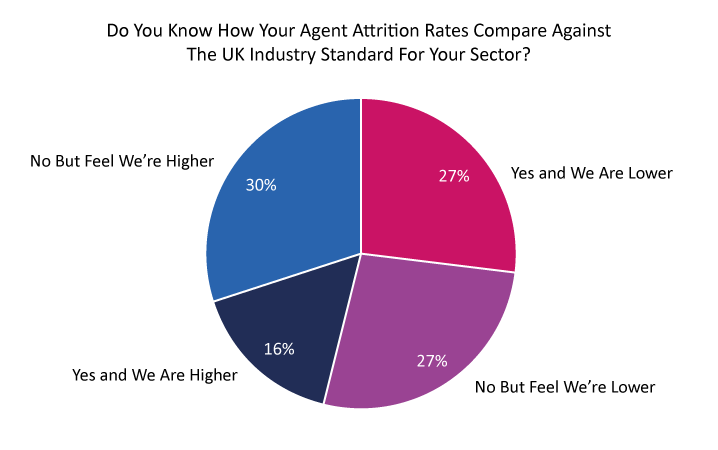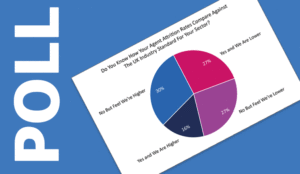Attrition occurs in all contact centres, but do you know how your attrition rate compares to others?
Ian asked our LinkedIn Community of industry professionals ‘Do you know how your Agent Attrition Rates compare against the UK Industry Standard for your Sector?’
150 people responded to the poll and, as the answers were quite surprising, we wanted to share them with you below.

| Attrition Rate vs. UK Industry Standard | Response % |
|---|---|
| Yes and we are Lower | 27% |
| No but feel we’re Lower | 27% |
| Yes and we are Higher | 16% |
| No but feel we’re Higher | 30% |
The responses are quite evenly split among three options, with only 16% choosing the outlier ‘Yes and We Are Higher’.
What is most interesting about the results of this poll is that 57% have chosen an option where they are unable to say with certainty how their attrition rates compare with the UK industry standard for their sector.
With attrition being a very real problem in the contact centre industry, the fact that so many of the respondents selected an option where they “feel” they are either higher or lower is incredibly surprising (30% – ‘No But Feel We’re Higher’, 27% – ‘No But Feel We’re Lower’).
If they are merely guessing, how do they know if their attrition levels should be a concern?
Also, with such a large percentage of respondents choosing an option based on a feeling, and not concrete fact, there must be something else at play – potentially that the respondents do not cross-reference their attrition with UK industry standards and may be using another source for comparison?
In positive news, 27% did select ‘Yes and We Are Lower’ as a response to the question.
There were also a number of comments from the participants explaining their selection and providing additional insights, which we also wanted to share with you:
Call Centre Roles Have Changed and It’s Had a Knock-On Effect
The shift to automation has had a negative impact on attrition rates.
Prior to automation, call centre employees were not seen as high priority, wages were not fantastic, and turnover was viewed as a positive – as those less suited to the role left of their own accord and replacing them was easy enough.
Then automation took hold – the driver being cost saving before customer benefit (just being very honest here).
This has altered typical call centre roles. They are more demanding and more extreme, yet little else has changed, including the salary, support and general prominence for those who undertake them in the eyes of their bosses or customers.
People are not ready to take a role under such conditions and for that level of pay, thus recruitment is harder. We have stood by whilst this has happened, and attrition is one of the consequences.
Call centre roles have undoubtedly changed, but their perception has not – especially from inside a business. The next step will be recognition and investment (less likely) or outsourcing (very likely).
Thanks to Keith
Attrition Is Extremely Costly
Attrition is an extremely costly business within the contact centre.
It is high risk, is damaging to teams (read: culture), and works strongly against the ambition to develop high-performing teams.
It very often acts as a strong indication that there may be room for big improvements in key operational areas where technology design, process and people promote good, or bad, performance.
Thanks to Ian
Don’t Become Fixated on Attrition as a Single Measure
I feel we’ve become too focused on attrition as a single measure beyond its relevance and impact.
Thanks to Keith
If you are looking for more great articles on attrition, read these next:
- How to Combat Quiet Quitting in the Call Centre
- How to Calculate Attrition Rate – The Formula
- Top 20 Ways to Reduce Attrition Rates in Your Contact Centre
Author: Robyn Coppell
Published On: 2nd Feb 2023
Read more about - Contact Centre Research, Attrition



































